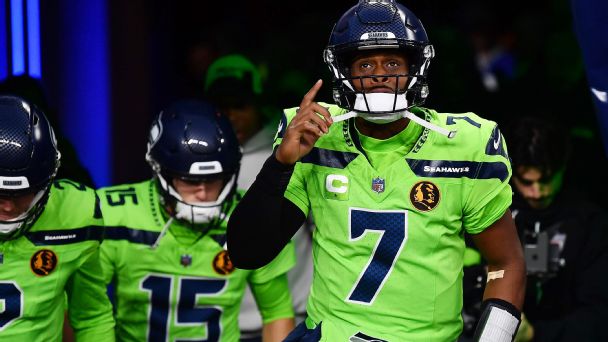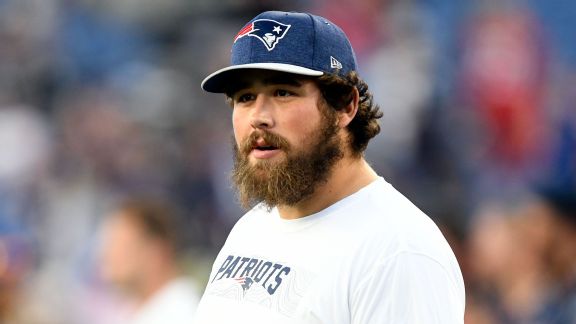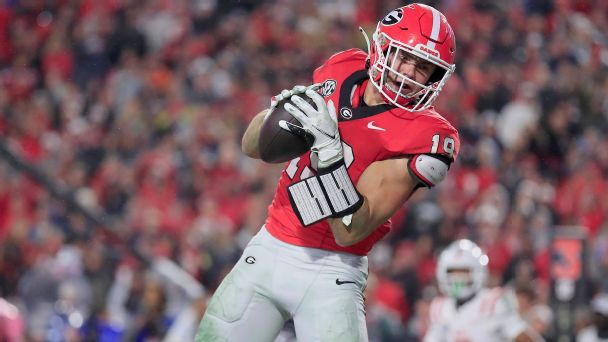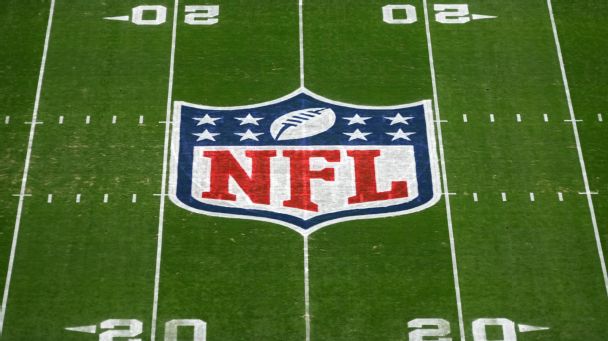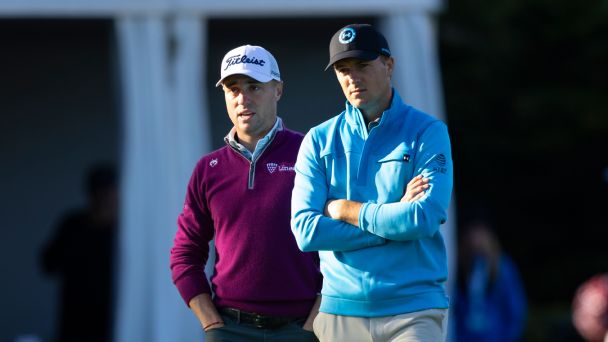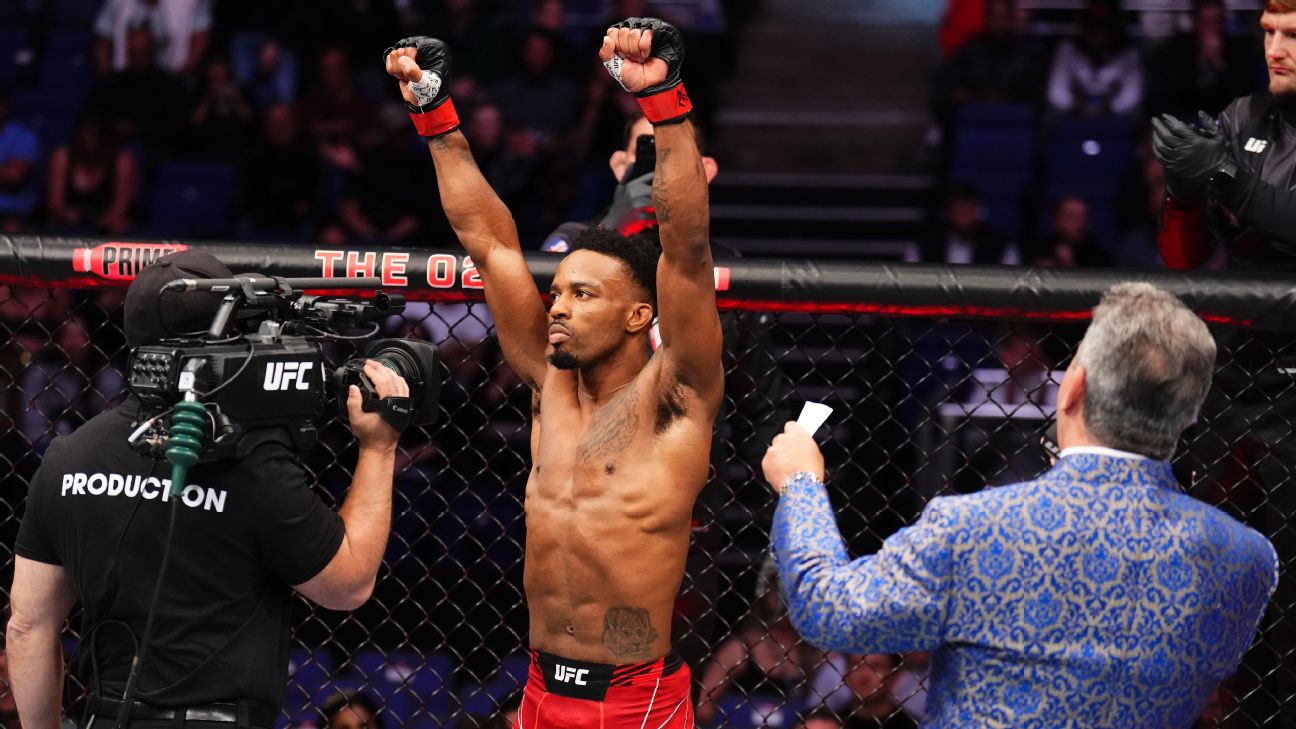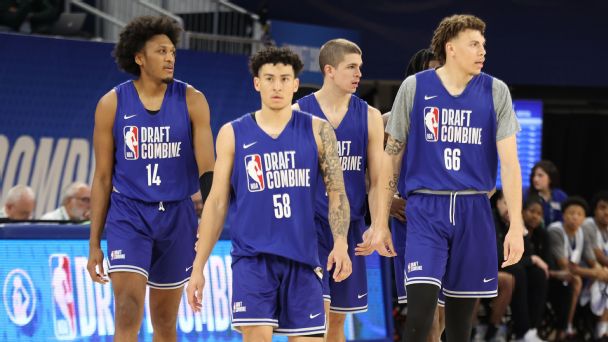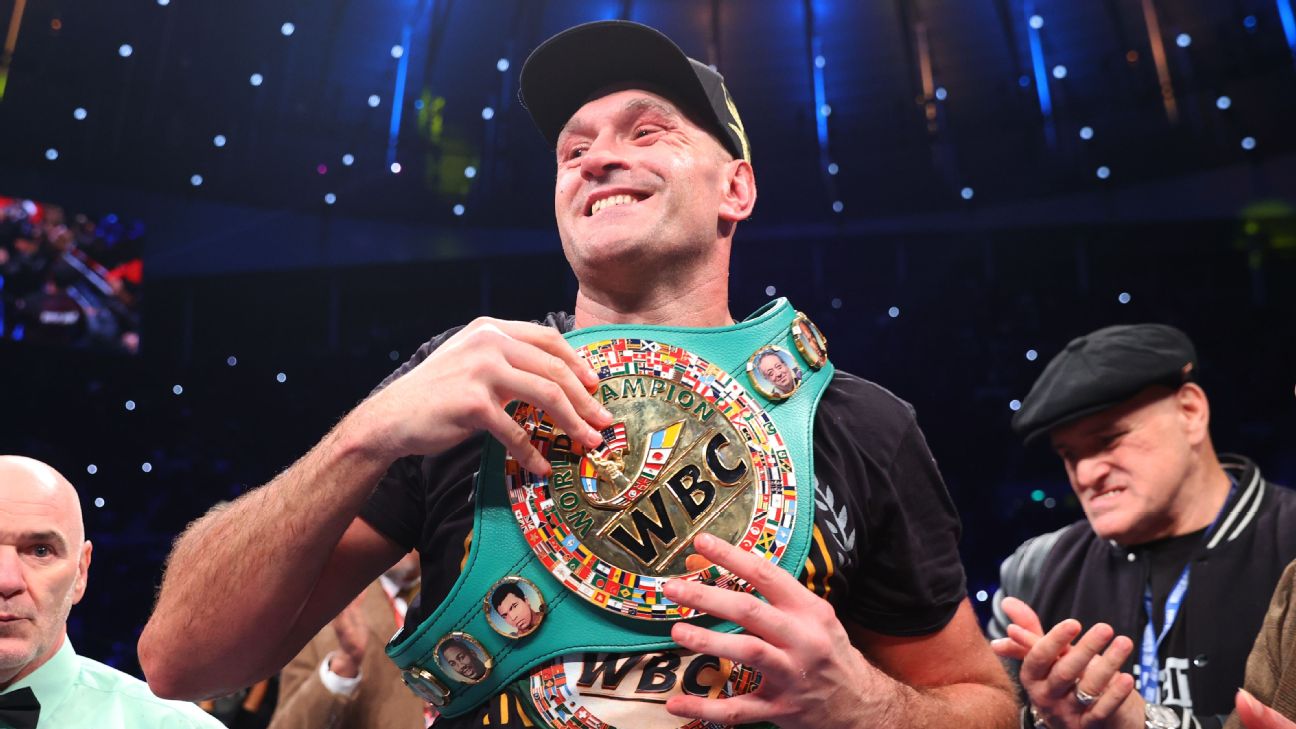![Michael Penix Jr. [608x342]](https://a.espncdn.com/photo/2024/0426/r1325019_608x342_16-9.jpg)
Raiders ready to experience the two-tight end life after drafting Brock Bowers
AS QUARTERBACK CHAOS played out before them Thursday night, the Las Vegas Raiders' 2024 NFL draft room held all of the emotions. There was surprise, bemusement, maybe a hint of resignation within the team's Henderson, Nevada, headquarters. Eventually optimism.
In a room where coach Antonio Pierce, general manager Tom Telesco and team owner Mark Davis were joined by more than 20 scouts, the Raiders, picking 13th, had expected to consider a "second wave" of first-round QB prospects that included Michigan's J.J. McCarthy, Washington's Michael Penix Jr. and Oregon's Bo Nix.
Once Las Vegas found itself on the clock, that wave had already crashed ashore.
Six quarterbacks, including McCarthy, Penix and Nix were gone in the first 12 selections, the highest concentration of QBs ever taken in a 12-pick stretch of the draft. What's more, the first 14 picks all came from the offensive side of the ball -- including the Raiders taking Georgia tight end Brock Bowers at No. 13. Never in the NFL draft's nearly 60-year history had 14 straight offensive players been selected, much less 14 straight at the top of the draft.
"I was surprised by the [offensive] run and how it happened, to be honest," a Raiders team source said.
The headline, as is usually the case in the draft, was about the quarterbacks. The run on QBs said plenty about the premium nature of the position in the modern NFL, coupled with the rookie wage scale's low barrier to entry in selecting one. A lot of quarterbacks at the top of the first round? Sure, NFL insiders said, it could be repeated.
But 14 straight offensive players? NFL scouts and executives who spoke to ESPN expressed emotions such as bewilderment and surprise over the way that played out, even while relaying a knowing sense of the factors that caused the feeding frenzy to occur.
It just happened, they said, and is unlikely to happen again anytime soon.
"There are really no dots to connect," one NFL executive said. "The better players were on that side of the ball this year."
THE 2024 DRAFT is destined to be viewed through history's lens as a quarterback draft, but it was elite talent at wide receiver and offensive tackle that NFL evaluators hold up as the critical factor in the 14-pick anomaly.
Pass-catchers Marvin Harrison Jr., Malik Nabers and Rome Odunze were widely expected to occupy three of the first nine draft slots, which they did by going to the Cardinals (No. 4), Giants (No. 6) and Bears (No. 9), respectively.
All three players are considered top-tier talents at a premium position. All three are cheaper alternatives to the robust veteran wide receiver market that has increased nearly 40% over the past five years.
Harrison's new contract with the Cardinals is slated to pay $35.4 million over four years, the Giants will pay $29.2 million to Nabers and the Bears $22.7 million to Odunze. Compare that to the four-year, $92 million contract free agent Calvin Ridley received from the Tennessee Titans in March -- Ridley is on his third team and has never made the Pro Bowl since entering the league in 2018 -- and the appeal of top-flight rookie receivers is clear.
Echoing this sentiment was Bills general manager Brandon Beane, whose team was included in trade speculation around 49ers stars Deebo Samuel ($23.9 million per year) and Brandon Aiyuk, a 2025 free agent in line for big dollars. Beane, tasked with managing the Bills' $2.9 million in remaining cap space, joked that if he could get Samuel for under that, he'd do a trade. Instead, the Bills drafted wide receiver Keon Coleman with the 33rd overall pick, a player whose four-year deal will cost around $10 million.
"Look at all these new [receiver] deals recently. They're hovering around $30 million [per season]," Beane told reporters last week. "So, trying to fit that in with everything we're doing, I'm not sure if it is reality right now."
Four offensive tackles going in the first 14 picks didn't surprise anyone, either. Just ask the Washington Commanders, whose general manager, Adam Peters, was working the phones after selecting quarterback Jayden Daniels at No. 2, looking at creative ways to reach back into the first round for a tackle. That ultimately didn't happen. The teams that selected tackles Joe Alt (Chargers, No. 5), JC Latham (Titans, No. 7), Olu Fashanu (Jets, No. 11) and Taliese Fuaga (Saints, No. 14) long had been linked to the position.
The most volatile position to project, as anyone who watched Thursday's drama now understands, was quarterback.
According to multiple sources, the Raiders had explored a potential move into the top three for a quarterback. LSU's Daniels, who played at Arizona State when Pierce was on the staff there, was the most viable candidate for the Raiders in any such scenario, sources said. During the pre-draft process, Daniels had shown interest in playing for his former coach in Las Vegas, sources said.
But the draft's consensus top quarterbacks, USC's Caleb Williams, Daniels and North Carolina's Drake Maye, went 1-2-3 to teams that weren't moving off their picks, deeming any inquiry futile. Telesco told reporters the team, in the end, did not pursue a trade-up "particularly hard."
"Everything else was smoke and mirrors," a Las Vegas team source said. "We weren't going to reach or overpay for a QB. Never was a worry and nothing frantic."
But the Penix selection at No. 8 was the major wild card. Several teams had a defensive player pegged for the Falcons, an organization that seemingly had filled its quarterback need by signing Kirk Cousins to a lucrative contract in March. Also, Penix was not universally considered a first-round talent in mock drafts, much less a top 10 pick, though his stock rose late in the process and teams thought more of him than analysts did. A Raiders source said the team would have considered Penix at No. 13, more so than McCarthy or Nix, but he was long gone by then.
"The Penix move turned the draft on its head," an official from another NFL front office said. "The room perked up after that selection. But it only takes one team, and if you're comfortable with the injury history, his performance last year was worthy of a high pick. He's a great thrower of the football. And it's hard to knock them for loading up on the game's most important position."
The remaining quarterback dominoes fell due to necessity, and for teams outside the top 12 who coveted one, it was bad timing. Minnesota, which occupied the No. 11 spot, had called its shot on a quarterback earlier in the offseason by trading with Houston to acquire the 23rd overall pick, ammunition for a draft-day trade up. The Vikings needed to move up only one spot, in a trade with the Jets, to acquire McCarthy. Minnesota felt good about the top six quarterbacks based on the pre-draft process, and the overwhelming feeling around the league was the Vikings were walking away from the draft with a passer selected at either No. 11, No. 23 or via trade.
Nix to Denver at No. 12 was more complicated. Many evaluators were high on him but, as with Penix, did not consider him a first-round pick. But Denver didn't have a second-round pick and had to pounce to get a passer head coach Sean Payton and the staff loved. As one team source said, the clear feeling in the building was Payton and general manager George Paton were determined to address the position once and for all with this draft. Denver's top receiver, Courtland Sutton, is going on his 10th different quarterback since 2018.
That left the Raiders with the unforeseen opportunity to draft Bowers, one of the best overall players in the entire draft and a player who garnered a high grade by everyone in their draft room. Few had expected Las Vegas to target a tight end one season after drafting Michael Mayer with the No. 35 pick last season -- the Raiders entered the draft with multiple defensive needs -- but the value was too great to pass up. One Raiders team source overheard talk in the war room about the increasing odds of getting a true "difference-maker" -- a familiar Telesco axiom -- at No. 13 given the frenzied quarterback run.
"We kind of figured there could be a lot of quarterbacks going early just by looking at the needs and who was there," Telesco told reporters after Day 1. "Figured somebody [at another position] may come down that maybe usually wouldn't. We didn't know who it would be. ... The draft is unpredictable. We do this for a living and we can't 100% dictate who will be there."
IN ONE EAST Coast draft room, a team official watched Penix's name scroll across the screen, turned to a fellow high-level colleague and asked, "Where are all the defensive players?"
The way several teams saw it, the lack of elite defensive talent made choosing a quarterback high -- reaching, it could be argued -- more palatable for teams in position to select one. Unlike some years, there was no league-wide agreement on the top players at positions such as cornerback and pass-rusher. Edge rusher Laiatu Latu, the first defensive player chosen, at No. 15 by the Colts, saw his stock take a hit because of past neck issues. Defensive tackle Byron Murphy II was a top-10 player on some draft boards but ultimately slipped to No. 16, where he was chosen by the Seahawks.
"There was really no premier defensive dude everyone was raving about," an AFC executive said. "That's why those guys didn't go early. There was no consensus about which player was the best at each defensive position. The elite talent was at tackle and receiver and a few quarterbacks."
Even so, the Vikings were pleasantly surprised when pass rusher Dallas Turner was still available in the early teens and started working phones to move up. Jacksonville was a willing partner at No. 17, figuring it could still address one of three positions -- cornerback, wide receiver or offensive line -- in a trade back to No. 23. The Jags, who also acquired several 2025 picks for their trouble, would zero in on wide receiver Brian Thomas Jr.
When the first-day dust settled, 23 offensive players had been drafted, the most ever in Round 1. But eventually, a defensive renaissance would bloom.
A total of 20 defensive players were selected in the second round, the most since 2016 and tied for the fourth most ever.
"The defensive players dominated the second round," an NFC executive noted. "That's just how it goes some years. Our war room wasn't surprised at all."
The 2025 draft could offer a further course correction from the offense-dominated first round of 2024. A pair of Michigan stars -- defensive tackle Mason Graham and corner Will Johnson -- are poised to be high on draft boards, as are Tennessee edge rusher James Pearce Jr. and Colorado's do-it-all corner Travis Hunter. And college football is nearly past the impact of COVID-19 on player development and "free year" transfer movement, which could bring more normalcy -- and shorter college careers -- back to draft boards.
Early narratives on the six quarterbacks and the 14 offensive players at the top of the 2024 class will have begun to form by draft time next year -- to include the typical blend of success stories and cautionary tales. But whatever the story of 2024 turns out to be, don't expect to see a draft with such an unusual breakdown in 2025 and beyond.
"This was a good quarterback class that I think will stand the test of time -- that's a big part of all this," a veteran NFC scout said. "Teams had to jump on them early."



